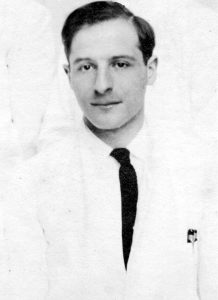
Mount Sinai in a time of Epidemic – Typhus, 1915
Mount Sinai physicians have a long tradition of making important contributions to the scientific literature. A good example is the following case from the 1910s, when typhus swept the world, killing thousands of people.
In 1910, Nathan Brill, MD, a doctor in the Department of Medicine, published a description of what he thought was the endemic form of typhus; this became known as Brill’s Disease. (Later Hans Zinsser showed that it was not endemic, but a mild recrudescent form of epidemic typhus and the name was changed to Brill-Zinsser disease.) In 1913, Harry Plotz, MD, an intern working in Mount Sinai‘s Pathology Laboratory, believed that he had discovered an organism that caused typhus. He published a Letter in JAMA in 1914 outlining his research.

Harry Plotz, MD as a Mount Sinai intern in 1915
Since this was such an important public health problem, in 1915, Mount Sinai’s Trustees took the unusual step of agreeing to fund a trip to gather blood specimens in the Balkans, where there was a typhus outbreak – and the early stages of World War I. As noted in Wikipedia: “disease ravaged the armies of the Eastern Front, where over 150,000 died in Serbia alone. Fatalities were generally between 10% and 40% of those infected and the disease was a major cause of death for those nursing the sick.”
The research results of this trip were described by the physicians Harry Plotz and George Baehr in a 1917 paper in the Journal of Infectious Diseases. The details of the trip itself are described in the 1916 Annual Report of The Mount Sinai Hospital This narrative also describes an additional trip by Dr. Peter Olitzky to Mexico, also funded by Mount Sinai, when the researchers in Europe were taken prisoner by the Austro-Hungarian government. This lengthy quote provides the Trustee President of Mount Sinai’s description of the events of 1915-16:
In pursuance of my remarks of last year in regard to the typhus expedition to Serbia, I wish to state that Drs. George Baehr and Harry Plotz after many difficulties established a laboratory at Belgrade in a hospital directed by the American Red Cross. Thirty-six hours before the bombardment of Belgrade, they left for Uskub and there set up a laboratory in the Lady Paget Hospital, and shortly thereafter the town was occupied by the Bulgarians. Very soon afterwards they were invited by the Bulgarian and Austrian Governments to work under their auspices. They then left for Sofia and afterwards went to Vienna, Lemberg and into Russia….
Because of the fact that Drs. Baehr and Plotz during the first six months of their stay in Europe, practically did not come in contact with typhus fever, it was considered important to send a second expedition into Mexico to determine the cause of the Mexican typhus fever, and to carry on other work which at that time we were not sure could be carried on in Europe. The second expedition consisted of Drs. Peter K. Olitzky and Bernard S. Denzer, accompanied by Mr. Irving Brout, a laboratory helper, and the expedition was under the guidance and care of Dr. Carlos E. Husk, a prominent surgeon attached to the staff of the American Smelting & Refining Co. The expenses of the expedition were defrayed in part by Trustees of the Mount Sinai Hospital and in part by the American Smelting & Refining Co.
It was first decided to go to Aguascalientes, but after the expedition reached Matehuala it was determined to remain there, as even at that distance from the border the danger, because of dis- turbances of international conditions, was very great. Early in March, because of the increasing danger in which the men were placed, they were requested to return. The members of the expedition did not, however, leave, because Dr. Olitzky had been stricken with a severe attack of typhus fever. Very shortly thereafter, the plants of the American Smelting & Refining Co. throughout Mexico were closed down, and Dr. Olitzky had to be removed to Laredo, Texas. Just before the departure Dr. Husk, who had been of the greatest aid in the accomplishment of a remarkable piece of work within four weeks, also fell ill of typhus fever, and was brought into Laredo in a very serious condition. Dr. Olitzky after going through a most dangerous attack of the disease, recovered, but unfortunately it proved impossible to save Dr. Husk’s life.
During the course of this expedition the same germ was found in the typhus fever cases in Mexico as had been found in New York and as was found by the members of the European expedition in Serbia, Bulgaria, Austria and Russia. Apart from that, the typhus germ was cultivated repeatedly from lice, which have in recent years been considered the agent in transferring typhus fever from one person to another. Some further scientific studies were made, and vaccination done on a rather large scale. The results of the vaccination cannot be determined at the present time because of the unsettled conditions in Mexico.
In the end, no successful vaccine has been developed for typhus, but antibiotics and public health measures have made it a treatable, rarely fatal disease in the U.S.
The story of typhus and Mount Sinai is important because it shows the institution’s commitment to research and developing new treatments during times of crisis. As shown here, this commitment is not solely from the medical and scientific staff, but also from the Trustees and supporters of Mount Sinai. When times are dire, as in today’s COVID-19 pandemic, Sinai finds a way to enable the work to get done to advance medical knowledge and improve the treatment of patients.


